Dehradun September 2022 Vol. XV
Issue No. 177
Readers are
requested to send reports of philatelic activities in their area for
publication. Short write ups by the readers about, societies, publications and
philatelic requirements can be sent for inclusion in this bulletin to the
editor: j.jyoti9@gmail.com
Note- This bulletin is
only for circulation among a limited group of philatelists without any
commercial purpose. The bulletin will be sent to the readers only on request.
Those who wish to receive it regularly please reply giving the name of your
city / country with the subject SUBSCRIBE RAINBOW
Stamp on Indian Theme by Kyrgyztan for MONACOPHIL 2022
Editorial….
Dear Reader,
I am pleased to present September 2022 issue of Rainbow Stamp News. It is
a great feeling to see that physical Philatelic Exhibitions are being held
around the world after the trauma of COVID 19 and now replacing the virtual
exhibitions which were helplessly organized during the pandemic to maintain
social distancing. Life is coming to normal and once again, the philately is in
the grip of its original charm and grandeur. The pleasure is doubled when
Indian participants perform extremely well in International Philatelic
Exhibitions. Heartiest congratulations to all those who have participated recently
in international shows and won awards. It’s a great news that next National
Philatelic Exhibition ‘AMRITPEX 2023’ by India Post is proposed to be held in
New Delhi in February 2023 as a part of year-long grand celebration ‘Azadi Ka
Amrit Mahotsav’ (75 years of India’s Independence). Best wishes to organizing team,
participants and all those who are going to be part of this show. Now, it is
time to prepare the exhibits, select theme, put best philatelic material in the
exhibit and get ready for the participation in the National Philatelic Show.
All the best to each and every one !
This is all for this month. More in the next issue. Happy Collecting!
Contents
§ Editorial
§ From the Desk of
Naresh Agrawal
§ Recent Indian
Issues
§ In
The News
§ Thematic
Watch
§ Specialized Section
§ Beginners’
Section
§ New Issues from
Other Countries
§ Philatelic Clubs
and Society
§ Blogs &
Websites on Philately
§ Current Philatelic Magazines & Newsletters
AMRITPEX
2023 : A PHILATELIC SHOW, A GREAT
CELEBRATION
The
most pleasing and charging news for Indian philatelists is that even India Post
is coming up with its next National Level Philatelic Exhibition in forth coming
February 2023 in Delhi ( as gathered from PCI sources). This news has brought
cheers in Indian philatelic fraternity and so all the philatelists are eagerly
waiting for its official declaration and the release of prospectus and other
program schedules of this proposed exhibition. I myself is thrilled and eager
to have concrete information.
Well,
I think as time left is not enough, India Post should not delay announcement
and declare the program at the earliest. However, we philatelists should not
wait for this and start preparing for the show right from today itself.
But
we all must keep in mind that this show is being organized as part of
celebration of India’s glorious 75 years of independence i.e. Azadi ka Amrit
Mahotsav”. That is why the exhibition has been named as “AMRITPEX 2023”.
I
don’t know what exactly will the layout of displays and the functions during
the show but being hardcore Indian and a philatelist, I do think this show will
be different. It will be graced by quality exhibits, separate displays of
Indian Freedom Movement and the displays of post-Independence period showing
the development of free India in different parts of life. I understand the
atmosphere will be studded with
philatelic elements which shall speak out the history of India freedom struggle
before Independence and the changing and developing scenario of free India. In
other words, the celebrations will be at its peak through philately. We
always say philately for education, this time it will be philately for
celebration.
So
what I think is that this is nice opportunity for philatelists to show their
love for their mother country, to show their concern through philately.
Well,
as I have already said I am extremely excited to visit the show. I have started
thinking what probably would be seen during the show apart from quality
exhibits. I personally assume and look forward to see the designs of the covers
which probably would be released during the exhibition. Even release of some
stamps may be scheduled by India Post during exhibition. It will also be
interesting to see how the exhibition hall is decorated looking in to the theme
of the exhibition. Some booklets / brochures/ pamphlets may be designed
depicting Indian freedom events and freedom fighters though stamps. And post-independence
achievements of India through stamps and other philatelic materials. There are
so many such philatelic titbits which would
add interest to the show. Cultural programmes, a separate non philatelic
display of incidents of freedom struggle and great achievements of India and
Indians after independence through still models and pictures etc. might be
there.
Well
friends, my thinking and assumptions have no boundary and so should be yours.
This is not going to be a great philatelic show but a show which would be
remembered for the years to come. This show would create a different impression
in the minds of not only Indian philatelists but every Indian.
While
I look forward for the program at the
earliest, I also wish this show a great success. Looking forward to meet you
all there….
: Naresh Agrawal : email : nareshkumar1992@yahoo.co.in
Whatsapp : 9425530514
Recent Indian
Issues
2
August 2022 : Journey of the Indian Flag – MS Rs 75
20
August 2022 : Ondiveeran – Rs 5
1
September 2022 : 2nd International Tiger Forum – Rs 5
New Special Covers
15 August 2022 : Har
Ghar Tiranga :From Lucknow and other
philatelic bureaues
15 August 2022 : 50
Years of PIN Code
26 August : Shri KK
Modi
29 August 2022 :
National Sports Day, Bangalore
Special Cancellations
Tribute to Freedom Fighters
Special
Cancellations on freedom fighters with the celebration of azadi Ka Amrit
Mahotsav will be released from 1st Aug to 15th Aug from Dibrugarh Postal
Division under Assam Circle.
1. Rani Lakshmi Bai
2. Kushal Konwar (Assam)
3. Malti Mem (Mangri
Orangi)(Assam)
4. Kharageswar Talukdar(Assam)
5. Saheed Bhagat Singh
6. Bal Gangadhar Tilak
7. Tikhewar Borgohain(Assam)
8. Kanaklata Barua(Assam)
9. Mahatma Gandhi
10. Maniram Dewan(Assam)
11. Sardar Vallabhbhai Patel
12. Durgeswar Sharma(Assam)
13. Ullash Dutta(Assam)
14. Bhogeswari
Phukanani(Assam)
15. Netaji Subhas Chandra Bose
Pune Ganesh Festival
Special cancellation released….
Stamp on Indian Theme by Kyrgyztan for MONACOPHIL 2022
An
exhibition of "100 iconic stamps and documents" will be held at the
Musée des Timbres et des Monnaies (Stamp and Coin Museum) with items from 100
world famous collections belonging to His Serene Highness Prince Albert II of
Monaco and to:
•
Her Majesty Queen Elizabeth II
•
10 postal museums
•
Members of the Club de Monte-Carlo
The
Monaco Top Cars Collection will host two exhibitions. The first will be devoted
to Napoleon Bonaparte and the second to India.The OETP (the Monegasque Office
for Stamp Issues) will be making its own special contribution by issuing
MonacoPhil commemorative stamps.
Recent
International Stamp Exhibitions
Madhukar Deogawanka & Virendra Sharma
Heartiest
Congratulations !!
Row 1: 1. OP Kedia, Piyush
Khaitan 3. M. Lokeswar Rao 4. Madhukar Deogawanka 5. SS Rath
Row 2: 1. Anup Rout
2. Pankaj Tyagi 3. Madhukar Jhingan 4. K. Sridhar 5. Joy Jyoti Ghosh
Row 3: 1. Ram Prasad 2.
Sandip Mujrani 3. Aditya Asthana 4. Ajay Agrawal
Row 4: 1. Dinesh Sharma 2.
N. Sridevi 3. Ramchandran Mahalingam 4. Virendra Sharma
View : Complete award List of Indian Winners
Visit : Indonesia 2022
Large Gold with Sp Prize to
Anand Kakad at Birdpex 9 Austria
Anand Kakad won Large Gold with Special Prize at BIRDPEX 9, Austria, the specialized worldwide stamp exhibition on Birds.
GASS 2022 Great American Stamp show by American Philatalic Society,
Sacramento CA USA from 25 - 28 August 2022
Mr Lokeswara Rao won following awards at GASS 2022
1.
Buddhist Mudras Single frame = Large Silver
Literature
Articles
1.
Buddhist Dances on Stamps article appeared Ananthapuri stamps Bulletin =
Vermeil
2
National Parks of USA on Stamps article appeared in Rainbow stamp News = Silver
SIPA AMRITPEX 2022
SIPA AMRITPEX 2022 National Level Stamp Exhibition was held at Chennai
from 13-15 August 2022 organized by South India Philatelists’ Association
(SIPA) Chennai. The exhibition was organized to celebrate the 75th year of
India’s independence. ribbon. During the exhibition a special cover was released
by Shri. S. Rajendra Kumar, CPMG, Tamilnadu Circle and the second edition of
the book “Stamp Collecting for Beginners” was released by Shri. G. Amarchand,
President of SIPA. The Lifetime Achievement Awards by SIPA was given to Shri. U
Mohan Rao, Shri. Roland Nelson and Mr. P.S. Seshadri. During the exhibition a
seminar was organized by The Royal Philatelic Society of London and a philatelic Quiz was also organized. The
seminar was conducted by the renowned philatelist Mr. Henrik Mouritsen RDP,
FRPSL on Thematic Philately and Exhibiting Techniques which was attended by
many eminent philatelists.
MVS Prasad, Guntur : Gold Medal
View Award List : http://rainbowstampclub.blogspot.com/2022/08/sipa-amritpex-2022-award-list.html
Covers and
Cancellations
Cape
Town 2022 International Stamp Exhibition
Mr. Shakil Ahmed is Indian National Commissioner for the Cape Town 2022. Exhibition Classes: Traditional, Postal History, Aerophilately, Postal Stationery, Revenue, Thematic, Open, Modern Philately, One Frame, Philatelic Literature and Picture Postcards only)
Shakil Ahmed : Email: ahmedshakil99@gmail.com : (M)
+91-9437225760 / +91-7008025663
Visit : https://capetown2022.org/
LIBEREC 2022
European
Stamp Exhibition and Polar Salon “LIBEREC 2022”
is organized by Svaz českých filatelistů, z.s. (Union of Czech
Philatelists) in cooperation with club “Evropská výstava poštovních známek
LIBEREC 2022, z.s.”, established for this purpose under FEPA patronage and with FIP recognition.
Venue:
Wellness Hotel Babylon https://www.hotelbabylon.cz/en/
Date: October 13th – 16th, 2022
Exhibition
size: 1200 exhibition frames
European Stamp Exhibition and Polar Salon LIBEREC 2022 : IREX
Visit : https://www.liberec2022.eu/en/aktuality-en/
IBRA 2023
IBRA 2023 and 33st International Stamp Fair will
be held at Hall 1 and 2, Messe Essen, Germany from 25 to 28 May, 2023. Mr.
Madhukar Jhingan is Indian National Commissioner for the IBRA 2023.
IBRA
2023 is being organized by the German Federation of Philatelists (BDPh) under
the Patronage of International Philatelic Federation (FIP) With a capacity of
2800 display frames, IBRA 2023 is the first General World exhibition since
2019, with participation open in all Classes - FIP Championship, Traditional,
Postal History, Postal Stationery, Aerophilately, Astrophilately, Thematic,
Maximaphily, Revenues, Modern Philately, Open Philately, Picture Postcards, One
Frame, Youth, and Philatelic Literature.
For the Rules of exhibition (IREX) please visit : https://ibra2023.de/wpcontent/uploads/2022/03/IREX-IBRA-2023-english.pdf
and for the Exhibit
Application forms please visit
https://ibra2023.de/wpcontent/uploads/2022/03/IBRA2023_ApplicationForm_engl.pdf
Please submit the duly
filled Forms with a copy of the first page of the exhibit to the
National Commissioner
for India, Madhukar Jhingan, mj@stampsofindia.com +919811160965 by Sep 19, 2022.
ANDHRAPEX- 2022
A state level philatelic exhibition will
be organized by the Andhtra Postal Circle in October 2022 at Vishakhapatnam.
Visit : andhrapex2022.blogspot.com
HYPEX – Diamond 2022
Hyderabad Philatelic and Hobbies Society
is going to organize an exhibition of stamps ,coins, notes and other
collectibles from 19 to 21 November 2022. For more details plz contact : Shri
Prakash Agrawal Ph. 9346777206 email : spagarwaal07@gmail.com
ASSAMPEX 2022
For detail visit : http://www.assampost.gov.in/
News from India Post
News from Philatelic Societies/Stamp
Clubs and Philatelists
LIMCA
BOOK OF RECORDS CERTIFICATE PRESENTED TO SUDHIR JAIN
Certificate
of Limca Book of Records 2020-22 has been presented to renowned Philatelist Mr.
Sudhir Jain in a grand function held at Satna on 29th August 2022.
Function
was jointly organized by Lions Club Satna and Central India Philatelic Society.
Satna Collector Mr. Anurag Verma presented this certificate to Mr. Sudhir Jain.
As per the entry in the latest Limca Book of Records, Mr. Sudhir Jain is having
"Largest collection of Philatelic items featuring Service
Organizations" which includes 1793 different stamps and covers from 158
countries on Rotary International and Lions International service
Organizations.
Mr.
Sudhir Jain is Governing Council member of Philatelic Congress of India,
President Central India Philatelic Society, Founder Chairman Jainism Philately
Group and Petron Indore Philatelic Society. His lot of Philatelic articles have
been published in the different magazines and newspapers of India as well as UK
and USA.
New Book on Philately
A
Book “Philatelic Paradise” by Dr
( Major) Ritu Kalra was released by Film Actor Anupam Kher on 23rd
August 2022 at Hotel Cecil, Shimla . Book available online , at Minerva book house Shimla and direct orders to Major Dr Ritu Kalra at 9816352225
Stamp Quizzes by Anil Dhir
A Handbook of Philatelic Trivia and
Quizzes
 Stamp Quizzes
by Anil Dhir, The Third Reprint of this Encyclopaedic
book first Published in 2008 is being reprinted on popular demand. Pages
: 275 : Hundreds of questions / answers. : Price Rs. 400/-. Offered
at Rs 125/- only. Postage included. Offer open till 10th September. The book is
recommended for all philatelists, stamp lovers and students who love
quizzing. Dispatch from 1st September. Those interested may kindly
contact Anil Dhir - email : anildhir2k5@hotmail.com Whatsapp
: 98610 20747
Stamp Quizzes
by Anil Dhir, The Third Reprint of this Encyclopaedic
book first Published in 2008 is being reprinted on popular demand. Pages
: 275 : Hundreds of questions / answers. : Price Rs. 400/-. Offered
at Rs 125/- only. Postage included. Offer open till 10th September. The book is
recommended for all philatelists, stamp lovers and students who love
quizzing. Dispatch from 1st September. Those interested may kindly
contact Anil Dhir - email : anildhir2k5@hotmail.com Whatsapp
: 98610 20747
Double theme - Flora and
Fauna
Fantasies of the Fauna
Diversity, in the natural environment, is sometimes
presented, apparently, as the result of an artist creating shapes and colours
whose perfection misleads the viewer who can attribute to an insect
characteristics strongly perceived as belonging to another species, like a
flower.
The four postage stamps with images of rare beauty are
presented under a defining issue title: Fantasies of the Fauna. The issue is
also special for collectors in that it addresses a double theme - Flora and
Fauna.
Pink orchid mantis (Hymenopus coronatus), featured as a variety of
colours on the stamps with the face values of Lei 4 and Lei 10.50 and on the
First Day Cover, is a species of mantis native to the tropical forests of
Southeast Asia. It shows a strong sexual dimorphism, as females being,
sometimes, 2 times larger than males. The coloration of this species, along
with the shape of its 6 petal-like legs, make this species an excellent ambush
predator.
Dead leaf mantis (Deroplatys truncata), illustrated on the stamp
with the face value of Lei 6.50, is a species of mantis, also native to the
tropical forests of Southeast Asia. As its name suggests, it resembles a dead
leaf, which helps it both when it comes to warding off predators and for
ambushing its prey.
Jewelled flower mantis (Creobroter gemmatus), rendered on the stamp with
the face value of Lei 10, is a species of mantis native to Asia. Thanks to its
colouring, it easily camouflages itself in the canopy of shrubs and trees,
where it waits for its prey, consisting of insects.
 ‘Bird’ is the most popular theme among
Thematic collectors. A large number of stamps on variety of birds found in
different parts of the world are issued time to time by many postal
administrations. It is a very good theme to develop. I am giving here a series
of articles on Birds by noted philatelist Shri M. Lokeswara Rao.
‘Bird’ is the most popular theme among
Thematic collectors. A large number of stamps on variety of birds found in
different parts of the world are issued time to time by many postal
administrations. It is a very good theme to develop. I am giving here a series
of articles on Birds by noted philatelist Shri M. Lokeswara Rao.Birds of Himachal on postcards
and Save Himachal birds
-M.Lokewara Rao
IFS (Retd.), PCCF
and Head of Forest Force (Retd)
There are three Himalayan zones
Western Himalayas (Jammu-Kashmir and Himachal Pradesh) Central Himalayas (Hill
Districts of Uttar Pradesh) Eastern Himalayas (Sangrila Range and Brahmaputra
Watershed) Himachal Pradesh can be divided into three zones outer Himalayas,
inner Himalayas and greater Himalayas. The Outer Himalayas: The altitude of
this zone ranges from 350 meters (1050 feet) to 1500 meters (4500 feet) above
mean sea level. This range of outer (lower) Himalayas is well known as
'Shivalik Hills' (also known as Manak Parbat in ancient times). Shivalik
literally means 'tresses of the Shiva'. The Inner Himalayas: - The altitude of
this zone varies from 1500 meters (4500 feet) to 4500 meters (13,500 feet)
above mean sea level. The Himalayas in this zone show a gradual elevation
towards the Dhauladhar (Dhauladhar means White Peak) and Pir Panjal Ranges. The
Greater Himalayas: The altitude of this zone ranges from 4500 meters (13,500
feet) to the highest points of the great Himalayas in different areas. The
Great Himalayan Range Rivers along the Eastern boundary. The Satluj river
divides it and separates the Spiti's (Lahaul-Spiti) drainage from Beas. The
climate in this zone is very suitable for cultivation of dry fruits. Rainfall
in this zone is low but Snowfall is very heavy. Snowfall in this zone starts in
the mid of October-November to March-April. The famous Zanskar Range is also
found in this part of the Himalayas which is the Easternmost range. This range
acts like a big wall by separating Spiti and Kinnaur from Tibet.
. As
per “Birds of Himachal Pradesh: species composition and conservation issues”
Anil kumar (2015) there are
total of 618 species of birds belonging to 20 orders and 91 families were
enlisted including some rare/interesting records and 276 species observed by
the author. About 48.7% of species were migratory. Of which, 16.18% were long
distance winter migrants followed by 6.02% passage migrants and 15.37% summer
migrants. While, 392 species were resident, including 75 species known to
migrate locally. The state supports the occurrence of a number of uncommon,
rare and threatened species. Out of 618 species, 42 (6.8%) belonged to
threatened categories of IUCN. Four species (i.e. Red-headed Vulture, White-rumped Vulture, Slender-billed
Vulture and Sociable Lapwing) were 'Critically Endangered', while three (i.e. Egyptian Vulture, Black-bellied
Tern and Saker Falcon) were 'Endangered'. Thirteen species belonged to
'Vulnerable' category followed by 22 species in the 'Near Threatened' category.
Apart from this, about 77 species were rare or scarce. Some of the species
found are Eurasian Coot, Northern Pintail, Common Teal, Little Cormorant, Great
Cormorant, GreyLag Goose, Northern Shoveler, Common Pochard, Red Necked Grebe,
Great Bittern, Lesser White-Fronted Goose, Red Crested Pochard, Ferruginous
Pochard, Pied Avocet, Northern Lapwing, Peregrine Falcon Bar-headed Goose GreyLag Goose etc The major threat to avian
diversity is loss, degradation and fragmentation of habitats owing to
unorganized development, agriculture expansion, forest fire, extraction of fuel
wood, timber and other forest produces.
As philately is a conservation tool, population which is an
important indicator of the ecological balance Himachal Pradesh Postal Circle
has released 20 Bird species
postcards of Himachal Pradesh in 2021 with distribution map on the reverse
of card to create awareness among people to protect and conserve the Himachal
Pradesh avian diversity as loss habitat
of birds is threatened because of
anthropogenic activities and climate change.
In 2007 at the 3rd
State Wildlife Board meeting, the Western Tragopan (Tragopan melanocephalus),
locally known as jujurana, the King of Birds replaced the Monal as the State
Bird of Himachal Pradesh.In 1975 stamp released by India Western Tragopan (Tragopan
melanocephalus) and post card released by himachal Postal circle issued
2021 which is the state bird of Himachal Pradesh.Tragopan (Tragopan melanocephalus) is one of the most colourful of the four
species of tragopan or Horned Pheasant that inhabits the Himalayas at altitudes
ranging from 1300 metres in winter to 3500 metres, in summer. The brilliantly
plumaged cock tragopans have two long brightly coloured fleshy horns one above
each side, which are erected during courtshipConservation Status:IUCN
Red List Vulnerable.
State Bird of Himachal Pradesh: 1975 Post card Western Tragopan (Tragopan melanocephalus) and post card released by Himachal Postal circle in 2021
The bids on the postcards released are Yellow Bellied Fairy Fantail, Great Barbet,
Brown Fronted Woodpecker, Yellow Breasted Greenfinch, Coal Tit, Himalayan
Bulbul, Red Billed Leiothrix, Western Tragopan, Spotted Forktail, Bar Headed
Geese, Himalayan Vulture or Himalayan Griffon, Green Backed Tit, Mountain Hawk
Eagle, Himalayan Monal, Golden Eagle, Blue Whistling Thrush, Kalij
Pheasant, Whiskered Yuhina, Verditer flycatcher andBlue
Throated Barbet
Great Barbet (Psilopogon virens) on the IUCN Red List since 2004 because
of its wide distribution Conservation status Least Concern. The great barbet is
an Asian barbet native to the Indian subcontinent and Southeast Asia, where it
inhabits foremost forests up to 3,000 m altitude. Yellow Bellied Fairy Fantail (Chelidorhynx hypoxanthus) It is yellow below and has a black eye-stripe, white wing-bar and broad black
tail tipped white. also known as yellow-bellied fantail, is found in the
Indian subcontinent, the Himalayas, and portions of Southeast Asia including
Thailand, Vietnam, and Myanmar.It is about 8 cm in size. Conservation
Status:IUCN Red List Least concern Brown
Fronted Woodpecker (Dendrocoptes auriceps) ranges across the northern
regions of the Indian subcontinent, primarily the lower-to-middle altitudes of
the Himalayas.Conservation Status:IUCN Red List Least concern.
Yellow Breasted
Greenfinch (Chloris spinoides) , is
native to the northern regions of the Indian subcontinent.
India Post 2021 Postcard Card Brown
Fronted Woodpecker (Dendrocoptes
auriceps) and Yellow Breasted Greenfinch (Chloris spinoides)
India
Post 2021 Postcard Coal Tit (
Periparus ater) Himalayan Bulbul (Pycnonotus leucogenys)
Coal Tit(Periparus ater) Combination of large black bib,
white wing bars, and broad white stripe on nape distinctive. Dazzling
geographic variation: Himalayan birds have a small, spiffy crest; Conservation
Status:IUCN Red List Least concern. Himalayan
Bulbul (Pycnonotus leucogenys) Sharp-looking bulbul with a spiffy mohawk. Note black face
and throat, bright white cheek spot, and yellow vent. A species of foothill and
montane forested areas.Conservation Status:IUCN Red List Least concern.
Red Billed
Leiothrix (Leiothrix lutea) a plump, brightly
colored babbler of dense forest understory. The yellow-orange breast and red
bill are distinctive. The tail feathers have a peculiar outward curve near the
tip. The song is a somewhat disjointed series of melodious phrases.Conservation Status:IUCN Red List Least concern.Spotted Forktail(Enicurus
maculatus) a
white forehead and a black crown and nape, a black back spotted white, and a
broad white wing bar. The tail is deeply forked, graduated black and white. The
white spotted back easily identifies this species from other similar sized
forktail.Conservation Status:IUCN Red List Least concern.
India Post 2021 Postcard Bar Headed Geese (Anser indicus) and Himalayan Griffon (Gyps himalayensis)
Green Backed Tit (Parus monticolus)
Its natural habitats are boreal forest, temperate forest, and subtropical or
tropical moist lowland forest.Colorful small songbird of foothill and montane
forests (up to 2800 m). with a bright yellow belly, greenish back, and two
narrow white wing bars rather than one broad one. Conservation
Status:IUCN Red List Least concern. Mountain
Hawk Eagle (Nisaetus nipalensis) is a large bird of prey native to Asia. Conservation
Adults are dark brown above
with thick brown bars on the belly and vertical black streaks on the throat. Status:IUCN
Red List Near Threatened.
Himachal Pradesh
Birds postcards released by India Post (2021) Himachal Pradesh Circle and
Conservation Status
|
S.No |
Common Name |
Scientific Name |
Conservation status IUCN Red List |
|
1 |
Great Barbet |
Psilopogon virens |
Least concern |
|
2 |
Yellow Bellied Fairy FantailIt |
Chelidorhynx hypoxanthus |
Least concern |
|
3 |
Brown Fronted Woodpecker |
Dendrocoptes auriceps |
Least concern |
|
4 |
Yellow Breasted Greenfinch |
Chloris spinoides |
Least concern |
|
5 |
Coal Tit |
Periparus ater |
Least concern |
|
6 |
Himalayan Bulbul |
Pycnonotus
leucogenys |
Least concern |
|
7 |
Western Tragopan |
Tragopan melanocephalus |
Vulnerable |
|
8 |
Red Billed Leiothrix |
Leiothrix lutea |
Least concern |
|
9 |
Spotted Forktail |
Enicurus maculatus |
Least concern |
|
10 |
Bar Headed Geese |
Anser indicus |
Least concern |
|
11 |
Himalayan Vulture |
Gyps himalayensis |
Near Threatened |
|
12 |
Green Backed Tit |
Parus monticolus |
Least Concern |
|
13 |
Mountain Hawk Eagle |
Nisaetus nipalensis |
Near Threatened |
|
14 |
Himalayan Monal |
Lophophorus impejanus |
Least Concern |
|
15 |
Golden Eagle |
Aquila chrysaetos |
Least Concern |
|
16 |
Blue Whistling Thrush |
Myophonus caeruleus |
Least Concern |
|
17 |
Kalij Pheasant |
Lophura
leucomelanos |
Least Concern |
|
18 |
Whiskered Yuhina |
Yuhina flavicollis |
Least Concern |
|
19 |
Verditer Flycatcher |
Eumyias thalassinus |
Least Concern |
|
20 |
Blue Throated Barbet |
Megalaima asiaticus |
Least Concern |
Himalayan Monal (Lophophorus impejanus) also known as the Impeyan monal and Impeyan pheasant, is a pheasant native to Himalayan forests and shrublands at elevations of 2,100–4,500 m. It is the national bird of Nepal where it is known as the danphe, and state bird of Uttarakhand. The male is the image of iridescence; green crested head, redneck, green shoulders, blue back, orange tail, and black underparts. When displayed or flushed, flashes a bright white patch on the back. Conservation Status:IUCN Red List Least concern.Golden Eagle (Aquila chrysaetos) It is the most widely distributed species of eagle. Like all eagles, it belongs to the family Accipitridae. They are one of the best-known birds of prey in the Northern Hemisphere.Conservation Status:IUCN Red List Least concern.
India Post 2021 Postcard Himalayan
Monal (Lophophorus
impejanus) and
Golden Eagle (Aquila chrysaetos)
India Post 2021 Postcard Blue Whistling
Thrush (Myophonus caeruleus)
and
Kalij Pheasant (Lophura leucomelanos)
Blue Whistling
Thrush (Myophonus caeruleus) Dark
purple with tiny silvery spots on head, back, and wings. Bill colour varies
with range: dark in central and eastern China and parts of mainland Southeast
Asia, bright yellow in populations elsewhere. Frequently fans tail while
standing on an exposed perch such as a waterside rock or overhanging branch.Conservation
Status:IUCN Red List Least concern. Kalij
Pheasant (Lophura leucomelanos) found in forests and thickets,
especially in the Himalayan foothills. A distinctive pheasant with bare red
facial skin, a backward-pointing crest, and a vertically compressed tail.Males
are rather variable depending on the subspecies involved, but all have at least
partially glossy bluish-black plumage, while females are overall brownish.Conservation
Status:IUCN Red List Least concern.Whiskered
Yuhina (Yuhina flavicollis) range extends across the Himalayan forests in
northern India to northeast Indian states, Nepal, Bhutan, Bangladesh and in the
east to Indochina.
Distinguished-looking small songbird with a brown mohawk of a crest.
Brown above and white below with an orange nape and a small black moustache
stripe. Slender white eye crescents give it a “spectacled” appearance on top of
a whiskered one. Conservation
Status: IUCN Red List Least concern.
India
Post 2021 Postcard Whiskered Yuhina (Yuhina flavicollis) and Verditer Flycatcher (Eumyias thalassinus)
Verditer
Flycatcher (Eumyias thalassinus) It is found from the
Himalayas through Southeast Asia to Sumatra. Beautifully vivid turquoise-blue
flycatcher. Adult male has dark lore. Juvenile is duller, with noticeably
grayer underparts. Sits upright on exposed perches.This species is named after
its distinctive shade of copper-sulphate blue and has a dark patch between the
eyes and above the bill base.Conservation
Status:IUCN Red List Least concern.
India Post 2021 Postcard Blue
Throated Barbet Megalaima asiaticus
The Blue Throated Barbet (Megalaima
asiaticus)
is an Asian barbet native to the foothills of the Himalayas and Southeast Asia.
It inhabits lowland and montane forests at elevations of 200–2,000 m (660–6,560
ft). It has bright green, blue and red plumage. The barbets get their name from
the bristles which fringe their heavy bills; this species eats fruits and
insects.Conservation Status:IUCN Red List
Least concern.
To spread conservation messages to protect Birds, Himachal
Postal Circle has released 20 Bird
postcards of Himachal Pradesh,
on the cover of these postcards Department of Posts, Himachal Pradesh Postal Circle t has
written a message to the people as follows
“This is a collection of passerine and non
passerine birds of Himachal Pradesh. This pack contains picture postcards of 20
bird species, mainly found in Himalayan and sub-Himalayan ranges of India.
These cards have been created with beautiful pictures of birds found in
Himachal Pradesh along with small write up and its distribution map, as to
create awareness among the philatelists, school children and nature lovers
about birds, its habitat, feeding habits and its significance in maintaining
balance in ecosystem. This efforts of
Department of Posts, Himachal Pradesh
Postal Circle will certainly bring new changes in Man- ecosystem relation ship
and its rejoicing with philately as a hobby”
The impacts of climate
change in the Himalayas are real. Increasing temperature, Melting glaciers,
erratic and unpredictable weather conditions and changing rainfall patterns,are
impacting the habitat of Birds of the
region.. Himachal Pradesh Himalayan birds are
losing their home ranges to birds from much lower elevations, who now
find the higher elevations hospitable because of changing climates,
temperatures and vegetation. Apart from Climate change , non climate
change factors (anthropogenic) also affect the habitat of the birds. There
should be a balance between development and conservation to save the habitat of
birds and it is also the duty of every one to lessen the carbon footprints to
save the beautiful birds of Himachal
Pradesh.
References:
1, Anil Kumar (2015) Birds of
Himachal Pradesh: species composition and conservation issues. High Altitude Regional Centre, Zoological
Survey of India, Solan - 173 211, India.
Journal of Experimental Zoology, India
2015 Vol.18 No.2 pp.505-529
3. www.Indiapost. Gov.in
4.www.himachalworld.com/himachal-geography/himalayan-zones-and-himalayas-in-himachal.html
5.www.himachalwatcher.com/2019/02/22/total-332-bird-species-located-in-himachal-pradesh/
7.https://avibase.bsc-eoc.org/checklist.jsp?region=INwhhp&list=howardmoore
- M.Lokewara Rao - email : madirajul@gmail.com
Specialized
Section
On great demand of many readers the article 'Disinfection of Mail' by Naresh Agrawal is being published here again in a series.. The article was highly appreciated by the readers around the globe.-Editor
DISINFECTION OF MAIL
Mail is the postal material which travels long
distances and is handled by various persons right from the sender to the
addressee. Climatic, geological and biological conditions all around the world
differs from place to place and time to time. Sometimes there are some
epidemics or contagious, infectious and communicable diseases spread in some
area which are likely to be transmitted through the mail. Also sometimes there
are chances of chemical or bioterrorist attacks
by so called militants through the mail system, sometimes some viruses get attached to the mail which are then spread to wherever the mail goes and
whosoever handles it or the mail in contact with the mail adds to the threat.
Interception and disinfection of mail at frontiers were some of the measures taken to control the spread of such contagious / infectious diseases or epidemics in earlier times. In times of spread of epidemics such as plague, cholera, small pox, typhus, yellow fever etc., which at some period were quite frequent at different parts of the world; the letters coming from suspected areas were subjected to special “treatment” ( sprayed, gassed, scorched, baked, irradiated, detained and soaked in the pursuit of cleanliness ) by health authorities for their disinfection.
Such treated letters were marked on the outside accordingly. Those markings were effected by variety of means such as wax, paper seals, hand stamps, affixed labels and manuscript notes. Those had the dual function of explaining the often-noticeable traces of the treatment and reassured the recipient that the letters were safe to open.
HISTORY OF MAIL DISINFECTION:
Long before during 14th century the causes of the sources of spread of epidemics were identified and the damages of dissemination of infection had been seen. To minimize the spread of plague ( probably the first identified epidemic) Venis and Genua prohibited the access of all those infected or under suspicion of being infected .
It was the Republics of Venice and Ragusa, (Dubrovnik) which first enforced quarantine from the 1370s. The same States introduced the 'perfuming' of mail from the Levant with sweet-smelling herbs and flowers a half-century later : a treatment which left no discernible traces.
In 1374 a well-known ordinance was issued in Visconto Bernabo of Reggio near Medona which brought in to being a complicated but a fantastic system of protective measures against contagion and set a practice followed allover for about next 500years.In 1377 the quarantine was evolved and put in practice officially in 1383.
In 1438, Venice moved far ahead of other places in creating and adopting sanitation methods as it created the supervisors of the health of the land under its megistry of health and endowed it with the large powers specified by the sanitary code. Ships and men were detained, cargo was unloaded in lazarettos, and susceptible articles were fumigated. When the state of health warranted, a reduction in quarantine period was correspondingly recommended.
 |
| 04.09.1666 Frankfurt : Main to Genoa Letters show scorching for disinfection in 1666/67 against Plague |
The process adopted did not have any scientific basis but the practice dates from before an understanding of the cause of contagious diseases, and the fumigant was as likely to be based on folklore. So, during this period the mail covers were smoked or drowsed with vinegar in Venice.
In the 18th and the 19th centuries not only the ports, but land frontier stations along the important trade routes served as barriers against the spread of epidemics. At the quarantine stations or at the military cordon posts; persons, merchandise, goods and mail were detained, isolated and decontaminated according to the regulations in force there at that time. The limited knowledge of that time was used to the utmost to check the spread of plague, typhus, small pox and later cholera. Thus an intriguing practice – decontamination or disinfection of letters was instituted throughout Europe and other parts of the world which continued nearly for 350 years.
After
the end of the 18th century, plague had not much effect in Europe
(other than Russia and the Balkans) though there were outbreaks sometimes
somewhere particularly in the Ionian Islands. But yellow fever seldom attacked
Caribbean, which had occasioned disinfection of mail coming from there, visited
ports in Spain and Italy in 1805, resulting in a resurgence of the treatment of
mail, even in Northern European countries.
In
1831, the western world faced a new threat i.e. cholera, which had escaped from
India routed to Europe via Persia and Russia in the contamination of water
sources resulting in adopting practices of treatment of mail in many countries
like Germany, Australia etc.. but by the mid-1840s disinfection was little
used, except in eastern Europe against plague.
Letter dated
10.05.1832 from New York City to Paris
with specific disinfection marking
SERVIZIO DI SANITA' MARITTIMA handwritten on entire letter to Health Authority at the Port of Anzio to attest authenticity - the Towers were used to monitor the Roman coastline, enforce a sanitary cordon when necessary and impose quarantine on suspect vessels
An epidemic of cholera in Egypt in 1884 resulted in a brief renewal of measures especially in Italy, but most countries anticipated the verdict of the 1893 International Sanitary Congress, that 'letters, news-papers and books should be free of all restrictions' - but only against cholera. The Americans still disinfected mail against yellow fever and bubonic plague on isolated occasions, most notably in Hawaii, and the Russians redoubled their efforts against Persia and the Far East in the 1890s when both plague and cholera raged, until 1911.
EUROPE
Austria Ibraila. 10.10.1868, Cover to Corfu endorsed ''Via
Costantinopoli'' have Two disinfection slits and minor acidic ink erosions and
small portion of paper loss at base
In the 20th. century, mail was very sensibly treated to prevent transmission of smallpox at different parts of the world.
In
1955, Americans were accused of using the mail as a means of
bacterial warfare by the Soviet-controlled regime in East Germany using the
idea as propaganda in a district where there was an outbreak of
paratyphoid fever.
The
anthrax scare in the U.S.A. in September 2001thought to be an act of
bioterrorism resulted in experimenting and adopting new methods of mail
disinfection i.e. by irradiating the
mail to kill the micro-organisms of the disease
also some actions in Europe and
Australia to check the possibility
spread there.
To be contd....
For Contributors : Guidelines for the articles
1. The
article should be a maximum of 10 pages (A4 size) including images in MS word
only. Long articles, if accepted, will be published in parts.
2. Do not Format your article. Like no text wrapping, no caption on the images.
Simply insert the images where required.
4. There should be No Hyperlinks in the text. Use only wherever it is quite
necessary.
5. Images should be clear and sharp. Blurred images will be deleted. Kindly
strictly avoid non -philatelic images.
6. The article will be published as per availability of the required space.
Beginners’ Section
Parent Teacher Association
On
February 17, 1897, the National Congress of Mothers was formed in US. which would later become the Parent Teacher
Association.
The
organization was the brainchild of Alice McLellan Birney and Phoebe Apperson
Hearst. Both mothers, Birney and Hearst were deeply concerned about the
welfare of children and believed in the importance of education in enriching
their lives.
In 1895, Birney first proposed her idea for an organization
to work on behalf of children. Over the next two years, she gained
support in her community. Hearst was the wife of wealthy businessman
George Hearst (and mother of William Randolph Hearst). Hearst opened the
first free kindergartens in San Francisco before moving to Washington, DC,
where she met Birney. Hearst convinced Birney that she should follow
through with her organization and helped arrange the first meeting.
That meeting was held on February 17, 1897, in Washington, DC. They had expected about 200 people to attend, but a total of 2,000 people turned out. While most of the people in attendance were mothers, there were also fathers, teachers, laborers, and legislators. During that meeting, Birney was made the president of the National Congress of Mothers and Hearst was made the vice president. Mrs. Letitia Stevenson (wife of Vice President Adlai Stevenson) was also made a vice president. Afterward, First Lady Frances Cleveland hosted a reception at the White House.
The Congress met the following year and promoted cooperation between parents and teachers. They also pushed for a national health bureau. In the coming years, they would also call on more fathers to join the organization and speak out for juvenile justice, child labor laws, and providing federal aid to schools. They also began providing hot lunches to children in schools and launched a campaign on child hygiene to reduce children’s mortality rates. During the 1920s, the National Congress of Colored Parents and Teachers was founded to support children in segregated states (they joined with the PTA in the 1970s).
In 1924, the organization adopted a new name, the National Congress of Parents and Teachers. It was also during this time that the PTA launched a crusade against illiteracy. In the 1930s, the PTA began a special nutrition project and provided emergency aid to prevent children from suffering during the Depression. They also began studying school bus safety.
In the 1940s, the PTA launched its nationwide school
lunch program. And in the 1950s, they held a conference on narcotics and
drug addiction in youth. The PTA also helped field-test and gain support
for the Salk Polio Vaccine. In the 1960s, the PTA spoke out about the
dangers of smoking and pushed for toy safety legislation. They also
created a nationwide cultural arts program and brought more attention to
home-school relations in low-income areas.
In the 1970s, the PTA spoke out about alcohol abuse
and violence on television and encouraged parents to take part in
decision-making in schools. In the 1980s, the PTA pushed for safety belt
legislation and created a drug and alcohol prevention program. During the
1990s, they launched a campaign to protect children from violence and worked
with other national groups to encourage parental involvement in early
education.
Today, the PTA operates in every state as well as the District of Columbia, US Virgin Islands, and Puerto Rico, with about 23,000 local organizations.
7. Regarding the selection and size of the images, the editor’s decision will
be final.
8. New, good and selective articles will be entertained for publication but strictly
subject to acceptance by the editor “. Articles already published somewhere
will not be accepted for publication.
Opening of the 1972 Summer
Olympics
On August 26, 1972, the Summer
Olympics, officially known as the Games of the XX Olympiad, opened in Munich,
West Germany. The first games held in Germany since 1936, they were overshadowed
by the “Munich Massacre.”
Munich won the bid to host the
games in 1966, beating out Detroit, Madrid, and Montreal. These would be
the second Summer Olympics to be held in Germany. The first had been in
1936, when the Nazi regime was still in power. The motto for the 1972
games was “The Cheerful Games,” and the official logo was a blue sun called the
“Bright Sun.” These were also the first summer games to have an official
mascot, a multi-colored dachshund named Waldi.
The games officially opened August 26, 1972. The opening ceremonies were held in the afternoon and included an extensive artistic display, including experimental music and children’s folk dancing. The ceremonies also included the first Officials Oath and the first woman to take the Athlete’s Oath.
The gymnastics competition was a part of the first modern Olympic games in 1896, and has been a part of the Olympic agenda continually since 1924. However, it wasn’t until the 1972 Olympics that the sport received a great deal of attention from the mass public. The person credited with bringing this excitement to the sport was a woman, Olga Korbut of the Soviet Union. She captured the hearts of millions as she took three gold medals. Audiences around the world saw Korbut’s dramatic performance, and soon most major countries began to promote gymnastics, particularly for women.
Perhaps one of the most memorable events of the
games was men’s basketball. The United States team, who had been on a
winning streak since 1936, faced-off against the Soviet team. With the
American team ahead 50 to 49, the Soviets had one last chance to score.
However, based on controversial referee decisions, the clock was reset by three
second, and the Soviets were given extra time, which they eventually used to
score the winning basket. Following “the most controversial game in
international basketball history,” the US team challenged the Soviet win, but was
denied. To this day, every member of the US team has refused to accept
their silver medal for the event.
Germany #B459-62 – West Germany stamps issued in 1970 to promote the games.
The US team’s Mark Spitz set a world record by
winning seven gold medals in a single Olympics. Spitz’s record stood
until 2008, when Michael Phelps, also representing the US, won eight gold
medals. And Frank Shorter became the first American to win gold in an
Olympic marathon in 64 years. Additionally, Dab Gable became the only
Olympic wrestler to earn a gold medal without having a single point earned
against him.
Bhutan
#147Gh –
Bhutan sheet honoring the Munich games
Handball and archery made their returns to the games after long absences – handball had last been held in 1936 and archery in 1920. Slalom canoeing made its Olympic debut at these games and badminton and water skiing were introduced as demonstration sports.
Sadly, the Games were overshadowed by an act of
terrorism known as the “Munich Massacre.” On September 5, eight
Palestinian terrorists broke into the Olympic Village and took 11 Israeli
athletes, coaches, and officials hostage. After negotiations broke down,
the Israelis were killed, along with five of the terrorists. Security
measures were increased, and competition was suspended for 24 hours to hold
memorial services. But the Olympic president insisted that the games
resume, to show that the terrorists didn’t win.
Source : Mystic Stamp
Co.
New issues
from other countries
Armenia
26 August 2022 : 10th
Anniversary of the Eurasian Economic Commission
Austria
26 August 2022 : Fly Agaric
Fly Agaric
Even people who know little about mushrooms can
usually spot a fly agaric, which stands out for its distinctive red colour and
white spots.
These white spots are formed when the
veil, which is the covering that surrounds the young mushroom, tears open and
remains of it stick to the cap. However, some mushrooms may have no white
spots, but orange or brownish spots instead. The gills, stem, and flesh of this
mushroom are white. Fly agarics are very common, and they usually grow under
spruce or birch trees, whose roots provide them with nutrients.
27 August 2022 BIRDPEX 2022
In 2022,
Birdpex (26-28 August 2022), a special exhibit dedicated to birds in philately,
took place in Austria for the first time. Birds are a popular subject in
philately.
The
commemorative stamp features a mute swan, which is the largest Austrian water
bird, one of the heaviest birds capable of flight, and a particularly majestic
bird. Swans remain attached to one partner throughout their lives, and both
parents take care of raising the young. The young still have gray plumage, and
their mothers sometimes even carry them on their back.
Great
Britain
1 September 2022 : Transformers
The Transformers – alien robots who can
change into vehicles, machinery and weapons – first appeared in toy shops and
on TV screens in 1984.
The stamps feature original illustrations created by
three established comic artists Andrew Wildman (pencils), Stephen Baskerville
(inks) and John-Paul Bove (colours) who have all contributed to The
Transformers UK comic series.
The stamp designs arranged in pairs depict an Autobot
and Decepticon locked in a battle, featuring eight characters in retro
Generation 1 style from the 1980s
Belgium
29 August 2022
: Frogs in Belgium
This sheet
from Belgium comprises of ten stamps and features five different species of
frogs. The illustrations of frogs are accompanied by the name of the
species".
Latvia
16 August
2022 : Latvian Architecture
Liechtenstein
9 September 2022 : Crypto Stamp
Switzerland
11 August 2022 : Our Switzerland
My Canton
– Our Switzerland
Cultural
and political diversity is one of our country’s strengths. At the same, shared
values and traditions unite us as “one Switzerland”. We are now celebrating
this unified diversity with a unique sheet of stamps entitled “My canton − our
Switzerland”.
Designers
from each of the 26 cantons have created a stamp for the project, complete with
a 27th stamp depicting the House of the Cantons. This building hosts the
Conference of the Cantonal Governments and other intercantonal organizations.
Together, these individual projects form a sheet of stamps that depicts both
the diversity of Switzerland and the uniqueness of each canton − a concept that
has never before been used in the history of Swiss stamps.
Swiss
Post and the Conference of the Cantonal Governments bring the public and the
cantons together − in their day-to-day work, and now also with the “My canton −
our Switzerland” sheet of stamps.
UN
19 August 2022 : World Humanitarian Day
On
19 August 2003, a bomb attack on the United Nations office in Baghdad, Iraq,
killed 22 humanitarian aid workers. Five years later, the General Assembly
adopted a resolution designating 19 August as World Humanitarian Day to express
solidarity with people affected by conflicts or natural disasters and pay
tribute to the humanitarian workers who help them.
Each year, World Humanitarian Day brings together
partners from across the humanitarian system to raise public awareness of
humanitarian work; to advocate for the survival, well-being and dignity of
people affected by crises; and to call for the safety and security of aid
workers.
This year, on 19 August, UN issued three stamp sheets for World Humanitarian Day, featuring beautiful artwork by award-winning illustrator Olga Shtonda from Kharkiv, Ukraine, to raise awareness and funding for humanitarian action. A surcharge will be added to the stamps, which will go directly to the United Nations Central Emergency Response Fund (CERF) to help people in need.
Philatelic
Clubs & Societies
Prayag Philatelic Society - https://prayagphilatelicsociety.org/
Ananthapuri
Philatelic Association, Thiruvanthapuram
Baroda Philatelic
Society - http://www.vadophil.org/
Chandigarh
Philatelic Club
Deccan Philatelic
Society – Pune, Maharashtra
Eastern India
Philatelists’ Association -http://www.filacapsule.blogspot.com/
The
Hyderabad Philatelic and Hobbies Society
India Study
Circle - http://www.indiastudycircle.org/
Indian Thematic
Society, Ludhiana -http://indianthematicstamps.webs.com/
Ludhiana Philatelic
Club
Numismatic & Philatelic Association of Vellore
Fort
http://numismaticphilavellore.site40.net/index.htm
Philatelic
Congress of India - http://www.philateliccongressofindia.com/
Philatelic
Society of Rajasthan, Jaipur
Philatelic
Society of India , Mumbai : http://www.psi1897.com/
Orissa Philatelic
Association, Mail id-: orissaphilatelic@gmail.com
Rainbow Stamp
Club -http://rainbowstampclub.blogspot.com/
Rajkot Philatelic
Society – Rajkot, Gujarat
Gujarat
Philatelic Association - Ahmedabad
South India
Philatelists Association - http://www.sipa.net.in/
The Army
Philatelic Society, Pune
Stamps of India –
http://www.stampsofindia.com
Blogs & Websites
RAINBOW STAMP CLUB
This
is a blog of e-Stamp Club www.rainbowstampclub.blogspot.com . The idea of
this blog is to extend the philatelic fraternity in all corners of the world.
Readers may write about themselves with their collecting interests and share
new ideas with other philatelists. New
Posts on recent issues, news on stamp activities, and Contributions by members
are published every day on this blog. Readers may also express their views on
any philatelic matter which will be published under Club News at Rainbow Stamp
Cub Blog. Philatelic Clubs and Societies may also send brief write ups. Readers
may send reports on new issues, special covers, cancellations & philatelic
activities of their area for inclusion in this Blog. - Editor
Current Philatelic Magazines – Newsletters
-VADOPHIL, Editor - Prashant
Pandya &TimirShah and published by Baroda Philatelic Society, Vadodara.
Website -http://www.vadophil.org/
-ITS Stamp News - Quarterly - Editor: Suraj Jaitly Publisher: Indian Thematic
Society website - http://itsstampnews.blogspot.com/
-Ananthpuri Stamp Bulletin - Monthly e -stamp bulletin of Anathapuri Philatelic
Association, Thiruvanthapuram
-Journal of the Army Philatelic Society
-India Post – Quarterly Journal of the India Study Circle publishes original
articles submitted by members of ISC.
-Deccan Philatelist edited by Dr Anjali Dutta email : dranjalidutta0303@gmail.com
from Deccan Philatelic
Society, Pune.
-The Hyderabad Philatelist from Hyderabad Philatelic and Hobbies Society Editor
– Shri Prakash Agrawal
-SIPA Bulletin issued by South India Philatelists’ Association
Acknowledgment
- Deccan Philatelist Vol 22 Issue No.2
2022 Edited by Dr Anjali Dutta
- Ananthapuri Stamp Bulletin September 2022 issue edited by
Mohanachandran Nair
- Judaica Thematic Society (UKSeptemberewsletter edited by Gary
Goodman
email : judaicathematicsociety@talktalk.net
-The Hyderabad Philatelist and The
Hyderabad Hobby Magazine edited by Prakash Agrawal
Courtesy - News and Image Resource to this issue : Orissa Philatelic Association, PPS Allahabad; SIPA, Philately Promoters, ; EIPA open Forum Whatsapp groups ; Dr Ritu Kalra-Shimla ; Sudhir Jain -Satna, Kasinath R. – Tanjore; M.Lokeswara Rao- Bangalore; Anil Dhir- Bhubaneshwar ; India Post; Praveen Shastry- Bangalore
Address for communication:
Jeevan Jyoti, c/o Mr. Ajay
Srivastav, PCCF & HOFF, HP Forest Deptt., Talland Shimla-171002, India . E-mail – j.jyoti9@gmail.com
A Request to Readers & Contributors –
· Please do not send the text in scan form or PDF. Send
your write ups in MS Word only.
- Last date for receiving articles/ News /write ups
– 25th of
every month.
- For articles : Kindly send images in
jpg compressed form and text in MS Word only Please do not use any formatting and text wrapping in
the article. Simply put the images under text where required.
- If you
like this issue please forward it to your friends and help in promoting
philately.
·
Please do not send forwarded messages for promotional
section if you want to give any information for promotion, please write
personally with brief write up. As this newsletter is not used for any
commercial purpose in any manner.
Attention
– Please do not
send text or image for publication in PDF.
Any
material from this newsletter may be reproduced only with the written
permission from the editor.
Happy Collecting ……….
Rainbow Stamp News is edited
and published monthly by Jeevan Jyoti from Dehradun (Uttarakhand ) India for free circulation
among philatelists.













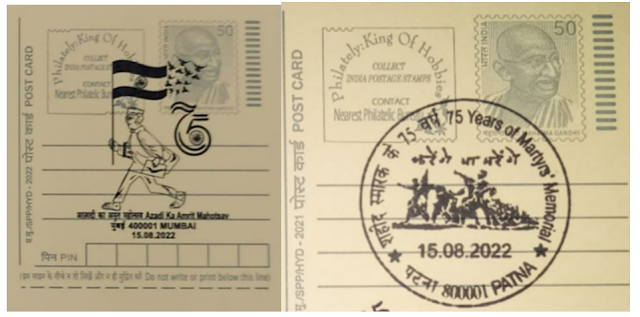
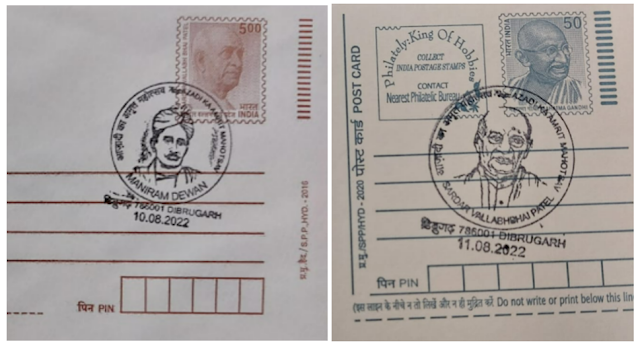
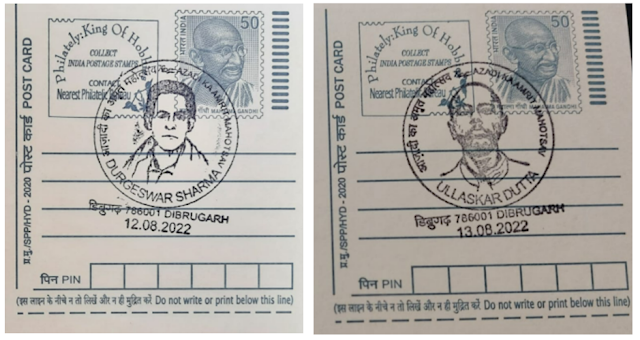








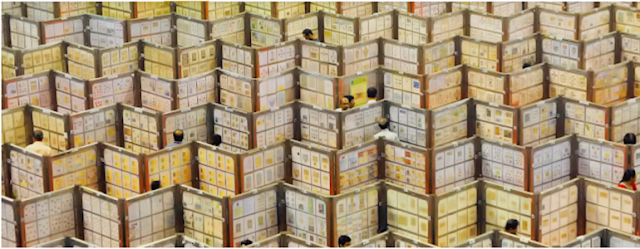






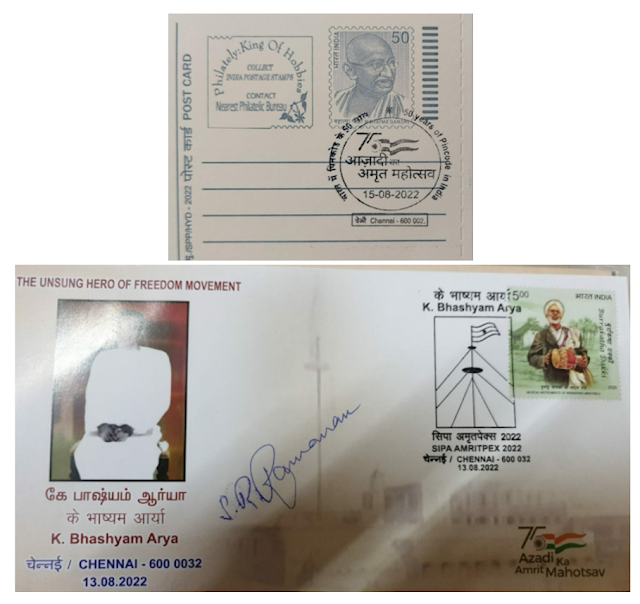





















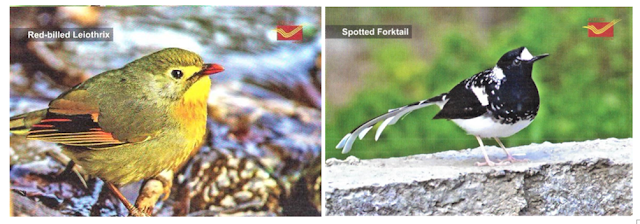



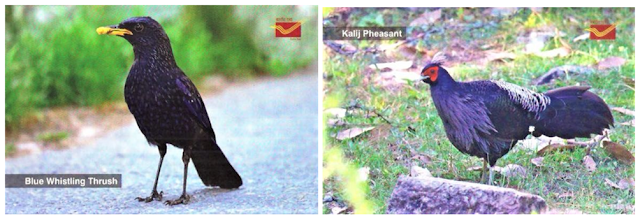













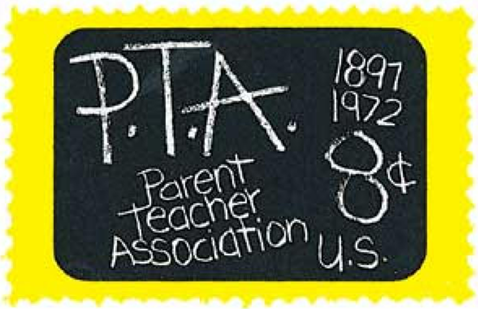

























No comments:
Post a Comment